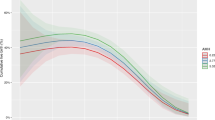Abstract
To investigate the developmental potential and clinical value of embryos with abnormal cleavage rate, a retrospective analysis was performed on 66 635 2-prokaryotic (2PN) and 1-pronuclear (1PN) embryos. The embryos were given conventionally in vitro fertilization (IVF) treatment and continuously cultured on the day 3 (D3) at the Reproductive Medicine Center, Tongji Medical College, Huazhong University of Science and Technology from January 2016 to December 2017. The embryos were separated into the day-2 (D2) undivided group with 106 cases, the arrested development group with 3482 cases, the blastomere reduction group with 541 cases, and the control group with 62 506 cases, respectively. The blastocyst utilization rates of these three abnormal groups were 2.83%, 10.86% and 6.84%, respectively, which were significantly different from that in control group (39.46%). Furthermore, 2 cases of anabiosis and 1 case of live birth were found in D2 undivided group. In arrested development group, there were 55 cases of anabiosis, 11 cases of clinical pregnancy in single-embryo transplantation (including 6 cases of live birth), and 25 cases of clinical pregnancy in combination with one normal embryo transplantation (including 23 cases of live births and 15 cases of dizygotic twins under B-ultrasound). There were 13 case of anabiosis in blastomere reduction group: there was 1 case of single embryo transplantation and clinical pregnancy was obtained; there were also 6 cases of clinical pregnancy in combination with one single normal embryo transplantation (including 5 cases of live births and 2 cases of dizygotic twins under B-ultrasound). In conclusion, embryos with abnormal cleavage rate still have the potential to continue to develop, and have certain blastocyst utilization rate and live birth.
Similar content being viewed by others
References
Balaban B, Urman B, Isiklar A, et al. The effect of pronuclear morphology on embryo quality parameters and blastocyst transfer outcome. Hum Reprod, 2001,16(11):2357–2361
Huang B, Li Z, Ren XL, et al. Free radical scavenging window of infertile patients with polycystic ovary syndrome: correlation with embryo quality. Front Med, 2017,11(2):247–252
Huang B, Qian K, Li Z, et al. Neonatal outcomes following early rescue intracytoplasmic sperm injection: an analysis of a five–year period. Fert Steril, 2015,103(6):1432–1437
Huang B, Hu D, Qian K, et al. Is frozen embryo transfer cycle associated with a significantly lower incidence of ectopic pregnancy? An analysis of more than 30,000 cycles. Fert Steril, 2014,102(5):1345–1349
Wang SS, ZhaoX, Ni XB, et al. The effect of cleavage mode on embryonic development potential. Zhongguo Xing Kexue (Chinese), 2015,24 (11):94–97
Athayde WK, Chen AA, Conaghan J, et al. A typical embryo phenotypes identified by time–lapse microscopy: high prevalence and association with embryo development. Fertil Steril, 2014,101(6):1637
Gardner DK, Balaban B. Choosing between day 3 and day 5 embryo transfers. Clin Obstet Gynecol, 2006,49(1):85
Hardarson T. Zygotes cleaving directly into more than two cells after 25–27 h in culture are predominantly chromosomally abnormal. Abstracts of the 22nd Annual Meeting of the ESIIRE, Prague, Czech Republic, 2006.
Neuber E, Rinaudo P, Trimarchi JR, et al. Sequential assessment of individually cultured human embryos as an indicator of subsequent good quality blastocyst development. Hum Reprod, 2003,18(6):1307–1312
Zhao YQ, Zhu GJ. Morphological observation of tubulin/spindle and nucleus/chromosome in noncleavage fertilized eggs. Zhongguo Fuyou Baojian (Chinese), 2010,25(25):3596–3599
Zhao Y, Ai J, Zhang H, et al. Polo–like kinase–1 regulates first cleavage of one–cell embryos in culture during assisted reproduction. Saudi Med J, 2010,31(3):247–252
Telford NA, Watson AJ, Schultz GA. Transition from maternal to embryonic control in early mammalian development: A comparison of several species. Mol Reprod Develop, 1990,26(1):90–100
Wong C, Chen AA, Behr B, et al. Time–lapse microscopy and image analysis in basic and clinical embryo development research. Reprod Biomed, 2013,26(2):120–129
Betts DH, Madan P. Permanent embryo arrest: molecular and cellular concepts. Mol Hum Reprod, 2008,14(8):445–453
Liu Y, Chapple V, Roberts P, et al. Prevalence, consequence, and significance of reverse cleavage by human embryos viewed with the use of the embryoscope time–lapse video system. Fertil Steril, 2014,102(5):1295–1300
Magli MC, Gianaroli L, Ferraretti AP, et al. Embryo morphology and development are dependent on the chromosomal complement. Fertil Steril, 2007,87(3):534–541
Ambartsumyan G, Clark AT. Aneuploidy and early human embryo development. Hum Mol Genet, 2008,17(R1):R10–5
Author information
Authors and Affiliations
Corresponding author
Additional information
This project was supported by the National Natural Science Foundation of China (No. 81801531) and Hubei Natural Science Foundation of China (No. 2017CFB262).
Rights and permissions
About this article
Cite this article
Wei, Yl., Zhu, Gj., Ren, Xl. et al. Developmental Potential and Clinical Value of Embryos with Abnormal Cleavage Rate. CURR MED SCI 39, 118–121 (2019). https://doi.org/10.1007/s11596-019-2008-4
Received:
Revised:
Published:
Issue Date:
DOI: https://doi.org/10.1007/s11596-019-2008-4




